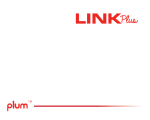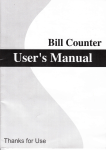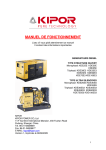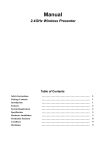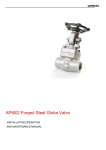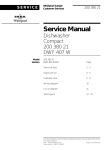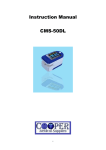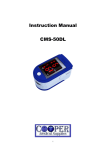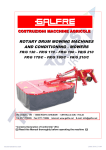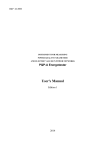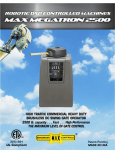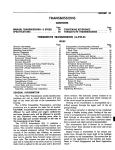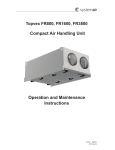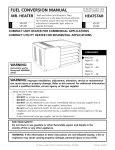Download 目 录 - Vervo Valve
Transcript
API602 Forged Steel Gate Valve INSTALLATION,OPERATION AND MAINTENANCE MANUAL TABLE OF CONTENTS GENERAL ARRANGEMENT DRAWINGS.....................................................2 1 GENERAL RULE.........................................................................................3 2 USAGE AND TECHNICAL PERFORMANCE.............................................3 3 OPERATING PRINCIPLE AND STRUCTURE SPECIFICATION...............3 4 VALVE TRANSPORT..................................................................................4 5 VALVE STORAGE.......................................................................................4 6 VALVE INSTALLATION...............................................................................4 7 USAGE AND MAINTENANCE.....................................................................4 8 POSSIBLE FAILURES, REASON & SOLUTIONS......................................5 9 QUALITY ASSURANCE..............................................................................5 10 SERVICE...................................................................................................6 1 2 1.General rules The gate valve produced in facility is standard product and designed in accordance with API 602. Enough Strength calculation has been implemented base on pressure class when design and supply certain safety margin. Valve is pressure contained equipments and has potential danger. From a security point of view, reading User Manual before usage to help you with selection, storage, installation, usage and maintenances. 2.Usage and technical performance 2.1Usage This valve is mainly used in petroleum, chemical, power plants and other industries, cut off or connected pipeline, so that causes normal operation of the system.. 2.2Technical performance Design standard: API 602 Structure Length: manufacturer standards、ASME B16.10 SIZE: 1/4’’~2’’ Pressure class: 150、300、600、800、1500、2500LB Applicable temperature: A105 : 0~425℃、F22:0~570℃、F5: 0~550℃ F316L: 0~450℃、F51:0~425℃ Test : API598 2.3Major parts material User selects valve material and pressure class based on work temperature, pressure, medium according to ASME B16.34 standard temperature and pressure level table. Manufacturer is only responsible for material, pressure class indicated in order. There is no responsibility for nonconformity caused by user selected pressure class and working condition 3.Valve working principle and structure specification 3.1Working principle The series product is cut-through gate valve. When hand wheel is clockwise rotation, gate disc drop to cut off channel, it is close. When hand wheel is anti-clockwise rotation, gate disc rise, it is open. 3.2Structure specification 3.2.1Valve ends connection adopts NPT, socket weld and flange structure. 3.2.2The valve adopts packing seal structure. Packing is soft graphite which widely used in international. 3.2.3Valve cavity seal adopts stainless steel graphite wound gasket. 3.2.4The valve adopts wedge seal form. Valve seal surface can be manufactured by API 600 3 specified material based on customer’s requirements. 3.2.5Hand wheel is common operation mode. The facility also can design suitable electrical device, hydraulic actuator and pneumatic actuator. 4.Transportation Users should prepare rope, lifting equipment and vessel and check up package. Broken package should be repaired before transport. Package has to meet standard requirements. Rotating packed hand wheel without permission is not allowed. Valve should be full closed. Regarding mis-opened valve, seal surface should be cleared and closed again, seal two ends channel. Gearing device and valve should be packed separately. Rope should be tied on support, hand wheel and stem are forbidden when transport and lifting. Valve Craning should be gentle, avoid knocking others and stably place. Valve’s paint, nameplate and flange seal should be protected when transport; dragging on ground and two ends seal surface movement on floor are forbidden. Don’t unpack valve which is not installed at the construction field. It should be place in safe place and rain-proof, dust-proof work should be well done. 5.Storage 5.1Valve should be placed in dry and ventilated room, valve channel and flange waterline should be sealed by protective cover. 5.2Stored valve should be inspected before usage to clear bilge and brush. Keeping seal surfaces clean and avoiding damage. Valve can be used after Pressure test is up to standard. 6.Installation 6.1Before installation, the valve marks should be checked whether its contents conform with the requirements. 6.2Before installation, the channel and seal faces should be checked and should not have filth attached. Any Filth attached should be cleared by soft cloth. 6.3Valve hand operating device should be inspected whether jammed or not. 6.4From Valve operating mechanism to floor should be about 1.2m when installation. When valve center and hand wheel is over 1.8m from floor, operation plate should be equipped for the often used valve. Valve with many pipes should be installed on operation plate for convenient operation. To the single valve infrequently use, it can adopt chain wheel, extension rod, active platform and active ladder, etc. when valve is installed under floor, it should be equipped with cover. 6.5Horizontals pipeline valve Stem had better be upright, instead of adown installation. Adown stem is not convenient to operating and repairing, but also is easily corroded. Lean installation of landing valve is not convenient to operating and repairing. 6.6Valve installed on pipe side by side should leave operation, repair, disassembly and assembly 4 space, the distance between hand wheel have to beyond 100mm. if distance is too narrow, valve should be installed staggeringly. 6.7User should select appropriate bolt, gasket for flange ends valve according to working temperature, pressure and medium. Bolt and nut should be tightened up. Bolt and nut should be full thread, over 1 inch bolt should equip with 8UN series thread. 7.Valve use and maintenance 7.1When test pipe or system pressure after installation, it is required to keep the disc fully open. It is not allowed to be opened partially and used as flow regulation and emergency depressurization device. Manufacturer is not responsible for the harms for this propose. 7.2Dust, oil contamination and vestigial medium accumulated on valve surfaces, stem, trapezoidal thread of nut, stem nut, active part of support and gear, valve is easily corroded and worn. It should be often cleared. 7.3Valve cavity thickness should be measured per three month. It should be replaced when the thickness is less than standard. Valve should be inspected regularly after in use, including seal and worn condition of seal surface, packing whether overtime or invalid, valve body whether corroded. Above circumstances existed, valve should be repaired again or replaced. If medium is oil or water, valve should be done one inspection and maintenance once three month. If medium is corrosion, valve should be inspection and maintenance once three month or implement local laws and regulations. 7.4Assembly, adjustment and seal performance test should be done again after inspection and maintenance.Changed parts list should be recorded for checking. 7.5Valve packing, gasket, bolt and nut can be selected and replaced by user themselves. Valve packing and gaskets can also be ordered as spare parts for repair when place order. Open bonnet or replacing bolt, nut or packing in pressure is not allowed. The valve replaced packing, gasket, bolt or nut can be used after pressure test is qualified. 7.6Maintenance of valve seal surface can be operated by user themselves, but tightness should be assured. Valve can be used after pressure test is qualified. 7.7Valve inner parts should be replaced normally, maintenance is not recommended. Inner parts had better select supplied parts. If user have no enough time to find manufacturer supplied parts, it should be manufactured strictly and replaced after it is checked and up to the standard. Manufacturer is not responsible for damage caused by parts which is not supplied by manufacturer. 7.8Maintenance of valve pressure contained parts is not recommended. If pressure contained parts has been used too long and lead to faults influenced safety, user has to renew valve. 7.9Welding and repair is not allowed in product line. 5 7.10 Valve installed in pipe is not allowed to beat, walk or support weight. 7.11Warning identification should be set when valve body temperature is too high, or isolated high temperature valve to prevent staff from scalding. 8 Possible failures & solutions Possible failures Reasons Solutions 1. The packing plate nut is too loose lock up the packing. 2. Packing coils are not enough Leakage of packing 1. Evenly tighten the screw nut to 2. Increase the packing coils 3. Replace packing with new one 3. Packing is used too 4. Stem should be repaired and long or kept improperly replaced regularly combined with to be ineffective. device and pipe inspection. 4.Stem seal surface is damaged. 1. Filth is attaching to Leakage between ends surfaces the seal surfaces. 3. Clear up filth completely 1. Repair and process again 2. Seal surfaces are damaged 1. Packing is pressed too tight Uneasily to turn hand wheel 1. Properly loosen the nuts on the packing cover 2. The threads of stem 2. Renew the stem screw nut screw nut are seriously 3. Correct or renew stem worn or crack 4. Clear up foreign matters 3. The stem bends. 4.There are foreign maters in valve-stem nut, pressing board, bushing, and stem Leakage at middle flange Leakage of body and bonnet damage 1. Meddle flange bolt is too loose. 1. Tighten up meddle flange nut 2. Replaced gasket. 2. Gasket is invalid. 1. Water attack 1.Steadiness is required avoid damages valve stopping pump inappropriately and 2. Endurance failure 6 3. Frost crack closing valve quickly 2.Renew the expired valve, endurance fault in early stage valve 3.Remove water medium if valve is not used in winter. 1.Gate disc is stuck in 1.Closing force is suitable, long lever valve. wrench is not necessary. Gate disc can not 2.Heated stem is 2. In warming up condition, gate be opened against gate disc. disc should be closed after a while. Hand wheel should be reversed a little when uninstalled stem. 9.Quality assurance 9.1 Valve quality assurance date is 18 months when delivery. Manufacturer is responsible for valve quality due to fault in material, normal operation and usage, but is not responsible for improper installation, repair and change. 9.2 User should notify manufacturer when they found quality problem. Manufacturer has the right to investigate the problems. 9.3 Business assurance for manufacturer is confined to following condition: — Material repair expenses — Expenses of renewing parts and material — Compensation of user purchases 9.4 Manufacturer is not responsible for damage caused by unexpected nature disasters and beyond the valve itself, such as earthquake and typhoon, etc. 9.5 User should negotiation with manufacturer about other assurances beyond the limited scope. 10.Service 10.1 Manufacturers supply on-site installation and debugging in accordance with contract. 10.2 Manufacturers trace valve quality and supply services based on customer’s requirements. 7








